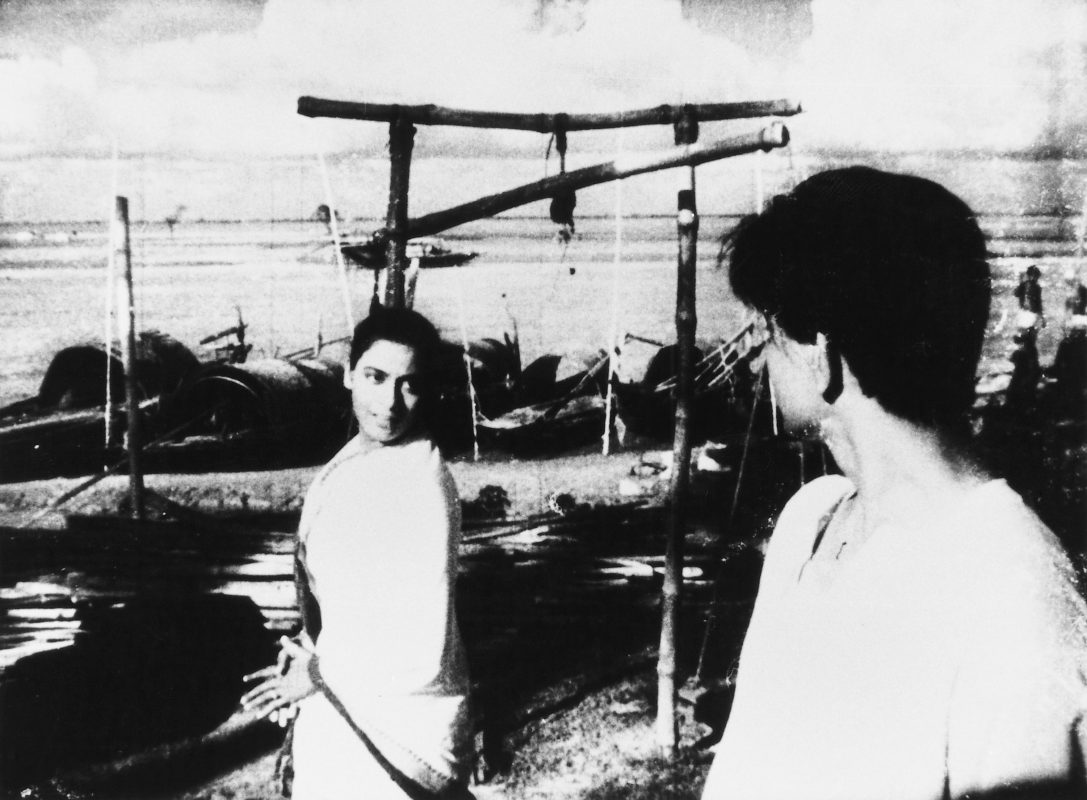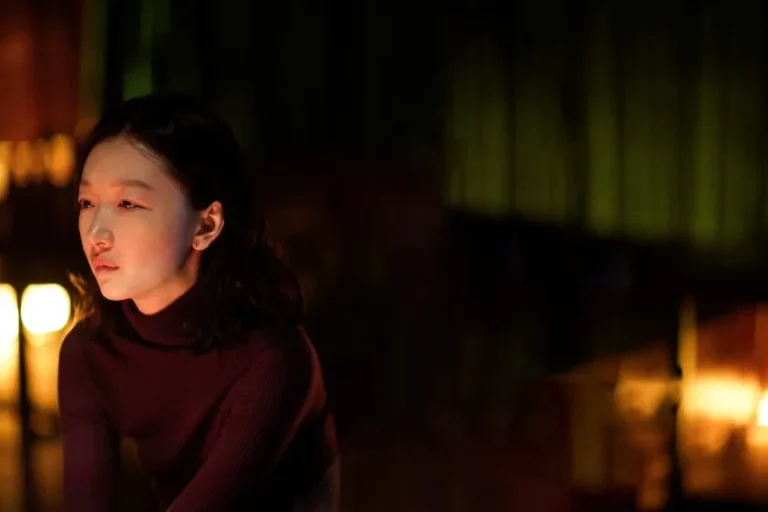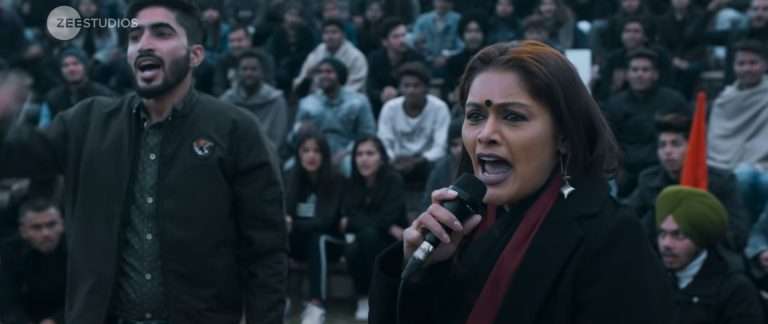Ritwik Ghatak deploys music and melodrama as essential devices for expressing melancholic longing for an estranged homeland. This is my second article exploring Ritwik Ghatak’s deployment of sound and music in film, and it will examine his musical strategies through “Komal Gandhar,” arguably the sunniest of all his works.
In “Komol Gandhar,” he brilliantly juxtaposes the different genres of music, from Indian Classical Music and Rabindra Sangeet to folk songs, to portray the inner dilemma of his protagonists, estranged from their motherland, which could have otherwise become very difficult to portray. It also shows how the different genres of music not only contribute to the portrayal of the cultural differences of ‘East’ and ‘West’ Bengal but also enforce and validate the diasporic identities of the refugees, while in the process paradoxically pointing out the unity and oneness of both the ‘countries’ as well.
Through this sonic architecture, Ghatak articulates his complex meditation on the nation-state, a preoccupation that reiterates itself in all his films. ”Komol Gandhar” can be accredited as a partial autobiography of Ghatak. The autobiographical form also becomes a means of articulating certain universals.
The artist, in portraying an external event, invests in his character something of the unexplained, his own feelings and biases. However, he did not let his ideologies, biases, and perplexities rule his films without any sound social grounding. A Marxian to the core, he did not bring out tragedies and happy moments without making socially relevant statements and connecting the audience with stark ground realities.
The IPTA activists used several models, ranging from the realist to the Brechtian to Bengal’s living folk and popular form, to bring to the forefront the issues they wanted to deal with. With a loud-speaker announcing the end of the first act of a play about partition and refugee, the film opens up directly to the theme of ‘partition’ and homelessness, and the first ‘stage’ dialogue by one of the characters resonate Ghatak’s own dilemma: “Why should I move away from home, my beautiful home, my bountiful river Padma?” The film, about a segregated theatre group allying once again for a majestic performance and its eventual failure, forms a microcosm of the partitioned Bengal.
In one of the scenes of the film, Ghatak takes us to the border, a utopic nowhere between “Epar Padma, Opar Padma.” In one sequence, Anasuya and Bhrigu disheveled in their nostalgia, uttering, “That’s a foreign land.” The word foreign is of utmost significance here for it at once makes something familiar and own, stark unknown, and forever distant.
The scene, accompanied by the Bhatiyali song “Epar Padma, Opar Padma,” presents not merely longing for a lost homeland but prepares the audience for a film steeped in epic melodrama, presenting the partition’s effects at socio-cultural and profoundly personal levels. East Pakistan appears in Ghatak’s films as an idyllic space, breeding prelapsarian innocence.
On the other hand, Calcutta has been time and again portrayed as a dumping ground of debris. Calcutta, to Ghatak, is a place which he loved to hate and hated to love. If East Pakistan is portrayed in the shadow of Emily Brontë’s Yorkshire moors, vibrant and innocent, then Calcutta resembles Dickens’ London, a dark world of apocalyptic stupor. Bhrigu’s dialogues identify Calcutta as dingy and claustrophobic.
Read More: All Ritwik Ghatak Films Ranked
Ghatak writes,
“The friends of mine who are into making parallel films almost despise the use of songs in films and do not really put songs in their films. But I do, and I will continue doing so if they help the story to succeed.”
Melodrama as a genre of the masses is unmade by the hermeneutics of a political revolution and class struggle in his films, thereby affecting the role of music, which was often used to accentuate melodramatic elements. Music constitutes one of his principal dialectical elements. It interrupts and strengthens the audience’s relation with the film in a paradoxical feat, transcending modernist self-reflexivity insofar as it reflects historical disjunction and political incommensurability of the divided land.
In film semiotics, the camera acts as sign-maker while actors remain mere participants in signification: the camera controls external space while actors control the internal space of emotion. In fact, the Stanislavsky School believes in the total dissolution of the actor into the character.
It is perhaps to bridge this gap between the audience and the characters that Ghatak extensively uses songs in his films. He uses songs to relive his characters rather than to create sound effects in his films. It is precisely with this intention that Ghatak uses both Classical Sangeet and Rabindra Sangeet together in his films, while, with the use of folk songs, he can bind his points of view within a definite spatio-temporal order.
Ghatak uses numerous folk songs in myriad ways. The song “Aam’er tolay jhumur” serves as an exemplar. It is an East-Bengali marriage folk song where the tone is not one of joy, but of separation: the separation of the bride from her mother and her new journey into the unknown. Interestingly, Ghatak uses this song while showing the title card: it acts as a prologue to “Komol Gandhar.” Against the black and white background suggestive of a conflagration, this melancholic song, sung in an East Bengal dialect, prepares the audience for a film enclosed in the world of refugees who try hard to cope in a divided world of absurdity.
In fact, all the folk songs that have been used in film work on a psychological level: they work together as a cluster to portray the inner trauma of the refugees in a new land, their utter helplessness and nostalgia, entwined in melodrama, when they come across something of their homeland. The young girls, who were married off at an early age, symbolize the homeless refugees with lost identities. Ghatak writes, “The main note of my Komal Gandhar was set on the unification of the two Bengals. Hence, throughout the film, we played tunes of old wedding songs…“
The adhunik songs have been used by Ghatak as symbols of defiance towards the partition of Bengal and the adherence to the system of divide and rule by the British. Songs like “Heiiyo ho” and “Esho mukto koro” express the director’s ardent appeal to the people to rise against the ill workings of the political system. Ghatak uses “Heiiyo ho” thrice in the narrative, though under differing circumstances.
Ghatak writes, “Exile and homelessness can teach us the joy of living internally as well as externally without boundaries and without borders.” It is specifically for this reason that perhaps he introduces Rabindra Sangeet. “Akash bhora surjo tara” is sung in Kurseong’s peaceful hilly terrain—the “natural” boundary between India and East Pakistan—acting as a contrast to Calcutta’s claustrophobic rooms.
The sound, songs, and silence in Ghatak’s films become autonomous, problematizing the concept of nation-state, Motherland, and the Marxist avowals to subjectivity, while, at the same time, shouting out loud Ghatak’s propagandist theme of unification of the two Bengals, thus establishing a harmonious rhythm of Bengal.
He writes, “The sound film has extended its scope, even as it has plunged into a search for something else, maybe into sadhana to reach the unspeakable, intense unity that belongs to music-the ultimate art…The quest for that is fulfilling, even as it helps us to understand and measure a film.” And he managed to meditate and intensify the pain of loss- a loss of motherland through the screen. And we must cry and agree.





![God of Dreams [2022] Review: An Hodge-podge of several Dystopian fictional tales](https://79468c92.delivery.rocketcdn.me/wp-content/uploads/2022/02/God-of-Dreams-2022-768x432.jpg)
![What Still Remains Review [2018]: A Question That is Successfully Asked](https://79468c92.delivery.rocketcdn.me/wp-content/uploads/2018/08/Select5-768x512.jpg)
![KIMI [2022] ‘HBO Max’ Review: Cyber Thriller Presents Both Sides of the Technological Boom](https://79468c92.delivery.rocketcdn.me/wp-content/uploads/2022/02/KIMI-2022-768x432.jpg)
